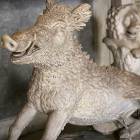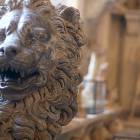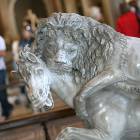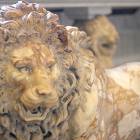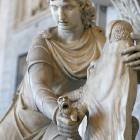The surprising zoo garden inside the Vatican Museum
One of the richest art collections in the world, the Vatican Museum has an entire section dedicated to animal sculptures (Sala degli animali). Displayed here are creations from antiquity to renaissance, some proving impressive artistic qualities especially in reproducing body movement, muscles and tension. Painstakingly details, like the hair in lion’s mane or the fur of a boar, are eloquent of the level achieved by ancient art.
The most dynamic and dramatic scenes are those depicting hunting by lions or dogs. Even more surprising for the papal collection is the presence of mythological scenes of animal sacrifice and elements of pagan religions.
Animal sacrifice has been practiced in numerous prehistoric societies, often as a substitute to human sacrifice, for taming the forces of nature, ensuring fertility and gaining support of various deities. Often, the animal sacrifice implied a mystical conception of blood as force and symbol of life. This survives to this day in unsuspecting elements like the Jewish kosher or the Muslim halal meat, which is obtained from a slaughtered animal who’s blood has been drained while being alive and often conscious.
Since it was the most powerful domestic animal, the bull was a favorite sacrificial animal and also a venerated animal especially in the Middle East and Hellenistic world, as was the Egyptian Apis Bull. In Rome, the taurobolium was a popular public ceremony during which a bull was sacrificed and its blood was collected.
Independent of this or an esoteric side of this, the underground rites of Mithra took place in the underground of ancient Rome. The central icon of this cult was that of Mithras slaying a bull, a scene religiously presented with the same elements, either as a sculpture or as a painting. Though this religion came to Rome from the Orient, not all historians agree that Mithras, from the mystery religion is one and the same with Mithra, one of the Zoroastrian gods of Persia. In the statues found in the underground places of worship in Rome, Mithras is presented wearing a Phrygian cap, a hat with its tip pointed towards the front, which became a symbol of freedom. Similar hats were worn by Dacian nobility, tarabostes, by sorcerers and even by French revolutionaries. In the depiction of Mithras, the hero stabs the bull while looking towards the sun, and turning away from the moon. The position in which he mounts the bull is always the same, holding animal’s nostrils with his left hand, keeping one leg extended and one leg bent. The presence of other animals attacking the bull (taurus) in all depictions, like the dog (canis) and scorpion (scorpio), together with those of the sun and the moon have convinced many that the scene had an astrological significance to the initiates.
Though Mithra is than presented taking part in a ritual meal, consuming the bull along with a sun-god, is not clear whether the followers of this cult consumed cooked or raw meet of a bull, or it was all a symbolic act.
Killing a bull was also part of another rite, honoring the Greek god Dionysus, or his Roman version, Bacchus. During the festivities of this god of wine, women and men would enter a state of shamanic ecstasy, in a collective frenzy which involved sexual acts, dancing on loud wild music and destroying social norms. In the climax of these nocturnal rituals, the women following Dionysus were said to be capable of killing a bull with their bear hands, tearing it apart and consuming its raw meat.
Another character of ancient Greek mythology was the centaur. This creature was half man, half horse, with the naked bust of human and the four legged furry body of a horse. The centaurs were regarded as primitive, instinctive creatures, dominated by violent and sexual instincts. In Dante’s inferno, such creatures, armed with bow and arrows guard one circle, preventing the condemned to escape.
The most famous of the centaurs, Chiron, has the same aspect but quite the opposite character. He is wise and the best healer, teacher for many mythological heroes, including Dionysus and Achilles. A planet in astrology was named after him, and he also represents the zodiac sign of Sagittarius.
- Home Page
start page - Architecture
landmark buildings - Sacred architecture
places of worship - Nature
landscape photography - Concert
performing artists - Christmas
Santa Claus pictures
- Jooble
jobs for photographers - Escape
an out of control blog - Merry Christmas
The best organizer of Christmas parties - Astro photo
Eclipse hunting and astrological photography

